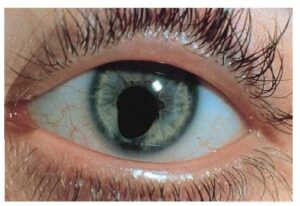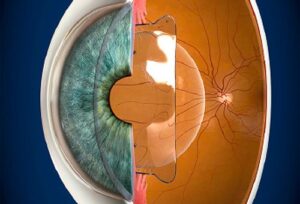
Anushka Super Speciality Eye Hospital
Call: 90044 44422 / 99213 44422 | Timings : 8.30 a.m to 5.30 p.m (Mon-Sat) | Add: Shri Swami Samarth Soc, Kaneri Dhamankar Naka, Bhiwandi




Accredited for Quality Care
Trichiasis: Causes, Symptoms, and Effective Treatment for Misaligned Eyelashes
anushka
16 October 2025
Our eyes are delicate organs that need every structure — including eyelashes — to be in perfect alignment for comfort and protection.
But sometimes, these tiny lashes grow in the wrong direction, rubbing against the cornea and conjunctiva. This condition is called Trichiasis, and though it may seem like a small problem, it can cause significant discomfort, irritation, and even corneal damage if left untreated.
At Dr. Anushka’s Super Speciality Eye Hospital, Bhiwandi, our expert ophthalmologists specialize in diagnosing and treating trichiasis using both medical and surgical approaches, ensuring lasting relief and protection for your eyes.
Let’s understand what trichiasis really is, why it happens, and how modern treatments can help you see and feel better again.
What Is Trichiasis?
Trichiasis is an eye condition where the eyelashes grow inward, toward the eye, instead of outward as they normally should.
These misdirected lashes continuously rub against the cornea and conjunctiva, leading to irritation, tearing, redness, and in severe cases, corneal ulcers or scarring.
It can affect one or both eyes and can involve a few lashes or the entire lash line.
Difference Between Trichiasis and Other Eyelid Conditions
Trichiasis is often confused with other eyelid problems. Here’s how it differs:
Condition | Description | Key Difference |
|---|---|---|
Trichiasis | Lashes grow in the wrong direction toward the eye | Eyelid position is normal |
Distichiasis | An extra row of lashes grows from abnormal openings | Two rows of lashes |
Entropion | The eyelid itself turns inward | Entire eyelid margin is inverted |
Understanding the difference helps in choosing the right treatment.
Causes of Trichiasis
Trichiasis can result from a variety of conditions, both temporary and chronic. The most common causes include:
- Chronic Blepharitis – Long-term eyelid inflammation that affects lash direction.
- Infections – Especially trachoma, a bacterial infection that can scar the eyelids.
- Eye Injuries or Burns – Trauma can distort lash follicles.
- Autoimmune or Skin Disorders – Such as Stevens-Johnson syndrome, pemphigoid, or sebaceous gland dysfunction.
- Age-Related Changes – Over time, tissues loosen and lashes can start to turn inward.
- Post-Surgical Scarring – After eyelid or ocular surgeries.
- Congenital (since birth) – Rarely, some people are born with lash misdirection.
In many cases, chronic inflammation and scarring are the underlying culprits.
Common Symptoms of Trichiasis
Patients with trichiasis often experience the following:
- Constant foreign body sensation (feeling like something is in the eye)
- Redness and watering
- Irritation and itching
- Sensitivity to light (photophobia)
- Pain or discomfort on blinking
- Blurry vision due to corneal scratches or tears
- Recurrent eye infections
If ignored, repeated lash contact can lead to corneal abrasions, ulcers, and scarring, which may permanently affect vision.
How Trichiasis Is Diagnosed ?
Treatment depends on how many lashes are misdirected, how frequently they regrow, and whether there’s underlying eyelid scarring or inflammation.
Below are the most common treatment options:
1. Temporary Relief – Epilation (Plucking of Lashes)
For a few misdirected lashes, the ophthalmologist can gently pluck out the abnormal lashes using sterile forceps.
- Quick and easy
- Provides immediate comfort
- But lashes may regrow within weeks, requiring repetition
This is often done as first-line or temporary treatment.
2. Electrolysis
A more permanent solution for a few abnormal lashes. A fine needle delivers a small electric current into the lash follicle, destroying it to prevent regrowth.
- Effective for limited lashes
- Minimal scarring
- May need multiple sessions
3. Cryotherapy (Freezing Treatment)
Here, a controlled freezing probe destroys lash follicles at sub-zero temperatures.
- Useful for larger areas of trichiasis
- May cause temporary swelling or pigmentation
- Excellent long-term results when performed by an experienced ophthalmologist
4. Laser Ablation
Modern argon or diode lasers are used to precisely target and destroy abnormal lash follicles.
- Bloodless, minimally invasive
- Quick recovery
- Particularly useful when traditional methods fail
5. Surgical Correction
If trichiasis results from entropion, scarring, or trauma, eyelid surgery may be necessary.
The surgeon can:
- Rotate the lash line outward
- Restructure the eyelid margin
- Remove and reconstruct scarred tissue
This provides a permanent and anatomical correction, especially in severe or recurrent trichiasis.
6. Lubricating Drops and Ointments
Artificial tears and protective gels are prescribed to:
- Reduce friction and dryness
- Soothe irritation
- Prevent corneal damage
These are supportive measures, often combined with procedural treatment.
Post-Treatment Care and Recovery
Recovery is usually smooth and quick.After treatment, your doctor may prescribe:
- Antibiotic or lubricating eye drops.
- Cold compresses to reduce swelling.
- Follow-up visits to ensure no new lashes have misdirected growth.
Most patients return to normal activities within 1–2 days after simple procedures and about a week after surgical correction.
Possible Complications if Left Untreated
Untreated trichiasis can cause long-term problems such as:
- Corneal abrasions or ulcers
- Recurrent infections
- Scarring and vision loss
- Chronic eye irritation
Hence, timely intervention is crucial to prevent permanent corneal damage.
Prevention and Self-Care Tips
While not all causes can be prevented, maintaining good eyelid hygiene and promptly treating infections can reduce your risk.
- Clean eyelids regularly to remove oil and debris.
- Treat blepharitis or conjunctivitis early.
- Avoid rubbing or plucking lashes at home.
- Protect your eyes from dust, smoke, and pollution.
- Go for annual eye check-ups, especially if you’ve had eyelid surgery or infections before.
Advanced Eye Care for Trichiasis in Bhiwandi
At Dr. Anushka’s Super Speciality Eye Hospital, our ophthalmic specialists use advanced slit-lamp imaging and precision instruments to:
- Identify even single misdirected lashes
- Offer customized treatment plans — from simple epilation to laser or surgical correction
- Ensure complete patient comfort and long-term results
With our NABH-accredited care and expert team, patients can expect safe, hygienic, and highly effective treatment for trichiasis and related eyelid disorders.
FAQs on Trichiasis:
Q1. Is trichiasis dangerous?
Yes, if untreated, the constant rubbing of lashes against the cornea can cause scratches, infections, and even vision loss. Early treatment prevents complications.
Q2. Does plucking the lashes solve the problem?
Plucking gives temporary relief, but lashes usually grow back in 4–6 weeks. Permanent solutions like electrolysis, laser, or cryotherapy are better for recurrent cases.
Q3. Can trichiasis come back after treatment?
It can recur if the root cause (like inflammation or scarring) persists. Regular follow-ups and managing eyelid hygiene reduce recurrence chances.
Q4. Is trichiasis painful?
The rubbing of lashes can cause discomfort or mild pain, especially when blinking. After treatment, the irritation quickly subsides.
Q5. Can trichiasis affect children?
Yes, though rare. It may occur due to infections, trauma, or congenital issues. Pediatric eye evaluation is essential if a child shows signs of irritation or redness.
Q6. Is laser treatment safe for trichiasis?
Absolutely. Laser ablation is precise, minimally invasive, and safe when performed by trained ophthalmologists.
Q7. What is the recovery time after trichiasis surgery?
Most patients recover within a week, though mild swelling or redness can persist for a few days.
Q8. Can trichiasis lead to permanent vision loss?
Only if it remains untreated for long and causes corneal ulceration or scarring. Early intervention completely prevents this.
Q9. What is the cost of trichiasis treatment in India?
Costs vary depending on the technique and hospital facilities. Minor procedures like epilation are inexpensive, while laser or cryotherapy may range from ₹5,000–₹15,000 per session.
Q10. Is trichiasis contagious?
No, trichiasis itself is not contagious. However, if it is caused by infectious trachoma, that infection can spread through contact.
Q11. Can I wear contact lenses if I have trichiasis?
It is not advisable until lashes are corrected, as contact lenses can worsen corneal irritation.
Q12. What should I do if symptoms come back after treatment?
Visit your ophthalmologist immediately. Early re-treatment of newly misdirected lashes prevents corneal injury and keeps vision clear.
Conclusion: Don’t Ignore the Signs of Trichiasis
Though trichiasis may begin as a minor irritation, it can have serious consequences if neglected. The good news is that it’s highly treatable — especially with modern tools like laser therapy and microsurgical correction.
At Dr. Anushka’s Super Speciality Eye Hospital, Bhiwandi, our team is committed to restoring your comfort and safeguarding your sight with the safest, most effective treatments available.
If your eyes feel irritated, watery, or scratchy — don’t wait. Book your eye check-up today and take the first step toward relief and clarity.
Recent Posts


